A Study of the Flexural Behavior of Fiber-Reinforced Concretes Exposed to Moderate Temperatures
Abstract
:1. Introduction
2. Materials and Methods
2.1. Materials
2.2. Methods
2.3. Experimental Program
3. Results
3.1. Characterization Tests
3.2. Flexural Strengths at Moderate Temperatures
3.3. Toughness
4. Discussion
4.1. Statistical Analysis of the Flexural Strengths at Moderate Temperatures
4.2. Comparison of the Results with Other Studies
5. Conclusions
- The outcomes derived from the beams tested in the three-point bending test showed that the post-peak flexural behaviors of the two MSFRCs (with P1 and P2 fibers) and the SFRC were not affected for a small CMOD (CMODa = 0.5 mm), after being stored for 60 days between 5 and 50 °C. The temperature effect was more noticeable for a larger CMOD (CMODb = 2.5 mm) for both FRCs and this factor may be considered to have a limited influence.
- The interaction of the pre-cracked condition with its exposure to moderate temperatures was influential at 35 and 50 °C for the MSFRCs with fiber type P1; that is, when the specimens were pre-cracked and exposed to moderately hot temperature. A drop in the residual flexural strengths was detected, but a specific study is recommended to better determine this influence.
- Toughness behavior was studied at these temperatures, and both steel and synthetic fibers provided good mechanical responses at the low and high temperatures in pre-cracked and uncracked states. The influence of the temperatures was similar for all properties regardless of the fiber material, given that that the dosage of each type of fiber was expected to deliver a similar mechanical concrete performance.
Author Contributions
Funding
Institutional Review Board Statement
Informed Consent Statement
Data Availability Statement
Conflicts of Interest
References
- Zollo, R.F. Fiber-reinforced concrete: An overview after 30 years of development. Cem. Concr. Compos. 1997, 19, 107–122. [Google Scholar] [CrossRef]
- Di Prisco, M.; Plizzari, G.; Vandewalle, L. Fibre reinforced concrete: New design perspectives. Mater. Struct. 2009, 42, 1261–1281. [Google Scholar] [CrossRef]
- Ministerio de fomento, Anejo 14, EHE-08. Available online: https://www.mitma.gob.es/recursos_mfom/anejo14borde.pdf (accessed on 23 June 2021).
- European Committee for Standarisation. Eurocode 2: Design of Concrete Structures—Part 1–2: General Rules—Sturctural Fire Design; AENOR: Madrid, Spain, 2011. [Google Scholar]
- Fib. Model Code; Fédération Internationale du Béton fib/International Federation for Structural Concrete: Paris, France, 2010. [Google Scholar]
- Bolat, H.; Şimşek, O.; Çullu, M.; Durmuş, G.; Can, Ö. The effects of macro synthetic fiber reinforcement use on physical and mechanical properties of concrete. Compos. Part B Eng. 2014, 61, 191–198. [Google Scholar] [CrossRef]
- Bernard, E.S. Age-dependent changes in post-crack performance of fibre reinforced shotcrete linings. Tunn. Undergr. Space Technol. 2015, 49, 241–248. [Google Scholar] [CrossRef] [Green Version]
- Yin, S.; Tuladhar, R.; Shi, F.; Combe, M.; Collister, T.; Sivakugan, N. Use of macro plastic fibres in concrete: A review. Constr. Build. Mater. 2015, 93, 180–188. [Google Scholar] [CrossRef]
- De Rivas, B. Characteristics of Steel and Polymer Based Fibre Concrete; Bekaert: Brussels, Belgium, 2019; pp. 1–6. [Google Scholar]
- Alberti, M.G.; Enfedaque, A.; Gálvez, J.C.; Picazo, A. Recent advances in structural fibre-reinforced concrete focused on polyolefin-based macro-synthetic fibres. Mater. Constr. 2020, 70, 206. [Google Scholar] [CrossRef] [Green Version]
- Plizzari, G.; Serna, P. Structural effects of FRC creep. Mater. Struct. 2018, 51, 167. [Google Scholar] [CrossRef] [Green Version]
- Pujadas, P.; Blanco, A.; Cavalaro, S.H.P.; De La Fuente, A.; Aguado, A. The need to consider flexural post-cracking creep behavior of macro-synthetic fiber reinforced concrete. Constr. Build. Mater. 2017, 149, 790–800. [Google Scholar] [CrossRef]
- Hall, C. Polymer Materials: An Introduction for Technologists and Scientist; Macmillan Education: London, UK, 1981. [Google Scholar]
- Jooss, M.; Reinhardt, H.W. The European guidelines for self-compacting concrete. Cem. Concr. Compos. 2012, 32, 1497–1504. [Google Scholar] [CrossRef]
- Kalifa, P.; Chéné, G.; Gallé, C. High-temperature behaviour of HPC with polypropylene fibres. Cem. Concr. Res. 2001, 31, 1487–1499. [Google Scholar] [CrossRef]
- Park, G.-K.; Park, G.-J.; Park, J.-J.; Lee, N.; Kim, S.-W. Residual Tensile Properties and Explosive Spalling of High-Performance Fiber-Reinforced Cementitious Composites Exposed to Thermal Damage. Materials 2021, 14, 1608. [Google Scholar] [CrossRef] [PubMed]
- Serafini, R.; Dantas, S.R.; Salvador, R.; Agra, R.R.; Rambo, D.A.; Berto, A.F.; Figueiredo, A. Influence of fire on temperature gradient and physical-mechanical properties of macro-synthetic fiber reinforced concrete for tunnel linings. Constr. Build. Mater. 2019, 214, 254–268. [Google Scholar] [CrossRef]
- Eidan, J.; Rasoolan, I.; Rezaeian, A.; Poorveis, D. Residual mechanical properties of polypropylene fiber-reinforced concrete after heating. Constr. Build. Mater. 2019, 198, 195–206. [Google Scholar] [CrossRef]
- Sogbossi, H.; Verdier, J.; Multon, S. Permeability and damage of partially saturated concrete exposed to elevated temperature. Cem. Concr. Compos. 2020, 109, 103563. [Google Scholar] [CrossRef]
- Choinska, M.; Khelidj, A.; Chatzigeorgiou, G.; Pijaudier-Cabot, G. Effects and interactions of temperature and stress-level related damage on permeability of concrete. Cem. Concr. Res. 2007, 37, 79–88. [Google Scholar] [CrossRef] [Green Version]
- Kiran, R.; Samouh, H.; Igarashi, G.; Haji, T.; Ohkubo, T.; Tomita, S.; Maruyama, I. Temperature-Dependent Water Redistribution from Large Pores to Fine Pores after Water Uptake in Hardened Cement Paste. J. Adv. Concr. Technol. 2020, 18, 588–599. [Google Scholar] [CrossRef]
- Buratti, N.; Mazzotti, C. Temperature effect on the long term behaviour of macro-synthetic-and-steel–fibre reinforced concrete. In 8th RILEM International Symposium on Fiber Reinforced Concrete: Challenges and Opportunities (BEFIB 2012); RILEM Publications SARL: Guimaraes, Portugal, 2012. [Google Scholar]
- Buratti, N.; Mazzotti, C. Experimental tests on the effect of temperature on the long-term behaviour of macrosynthetic Fibre Reinforced Concretes. Constr. Build. Mater. 2015, 95, 133–142. [Google Scholar] [CrossRef]
- Richardson, A.; Ovington, R. Temperature related steel and synthetic fibre concrete performance. Constr. Build. Mater. 2017, 153, 616–621. [Google Scholar] [CrossRef]
- Rambo, D.A.S.; Blanco, A.; de Figueiredo, A.D.; dos Santos, E.R.F.; Toledo, R.D.; Gomes, O.D.F.M. Study of temperature effect on macro-synthetic fiber reinforced concretes by means of Barcelona tests: An approach focused on tunnels assessment. Constr. Build. Mater. 2018, 158, 443–453. [Google Scholar] [CrossRef] [Green Version]
- Hannat, D.H. Durability of polypropylene fibers in portland cement-based composites: Eighteen years of data. Cem. Concr. Res. 1998, 28, 1809–1817. [Google Scholar] [CrossRef]
- Rossi, P. Critique of Synthetic-Fiber FRS Paper; TunnelTECH: Eberdingen, Germany, 2014; pp. 1–4. [Google Scholar]
- Steel—and Synthetic Fibre Reinforced Concrete—Which Fibres to be Used for Which Application and Why? Available online: https://bosfa.com/brochure/steel-and-synthetic-fibre-reinforced-concrete-which-fibres-to-be-used-for-which-application-and-why/ (accessed on 29 April 2020).
- Cifuentes, H.; Ríos, J.D.; Leiva, C.; Medina, F. Influencia del tiempo de exposición a altas temperaturas en el comportamiento en fractura de hormigones autocompactantes reforzados con fibras. An. Mecánica Fract. 2016, 33-047, 1–6. [Google Scholar]
- CEN—Comité Europeo de Normalización, UNE-EN 14651:2007+A1. Método de Ensayo para Hormigón con Fibras Metálicas. Determinación de la Resistencia a la Tracción por Flexión (Límite de Porporcionalidad (LOP), Resistencia Residual); CEN: Brussels, Belgium, 2008. [Google Scholar]
- Mazaheripour, H.; Ghanbarpour, S.; Mirmoradi, S.; Hosseinpour, I. The effect of polypropylene fibers on the properties of fresh and hardened lightweight self-compacting concrete. Constr. Build. Mater. 2011, 25, 351–358. [Google Scholar] [CrossRef]
- Richardson, A.E.; Jackson, P. Equating steel and synthetic fibre concrete post crack performance. In Proceedings of the 2nd International Conference on Current Trends in Technology, NUiCONE, Ahmedabad, India, 8–10 December 2011; pp. 1–6.
- Hasan, M.J.; Afroz, M.; Mahmud, H.M.I. An Experimental Investigation on Mechanical Behavior of Macro Synthetic Fiber Reinforced Concrete. Environ. Eng. 2011, 11, 18–23. [Google Scholar]
- Manfredi, R.P.; Silva, F.D.A. Test Methods for the Characterization of Polypropylene Fiber Reinforced Concrete: A Comparative Analysis. KSCE J. Civ. Eng. 2020, 24, 856–866. [Google Scholar] [CrossRef]
- Zerbino, B.E.; Barragán, R.L. Long-Term Behavior of Cracked Steel Fiber-Reinforced Concrete Beams under Sustained Loading. ACI Mater. J. 2012, 109, 215–224. [Google Scholar]
- American Society for Testing and Materials. Standard Test Method for Flexural Toughness and First-Crack Strength of Fiber-Reinforced Concrete (C 1018-97); ASTM: West Conshohocken, PA, USA, 1998; pp. 1–8. [Google Scholar]
- Pigeon, M.; Cantin, R. Flexural properties of steel fiber-reinforced concretes at low temperatures. Cem. Concr. Compos. 1998, 20, 365–375. [Google Scholar] [CrossRef]




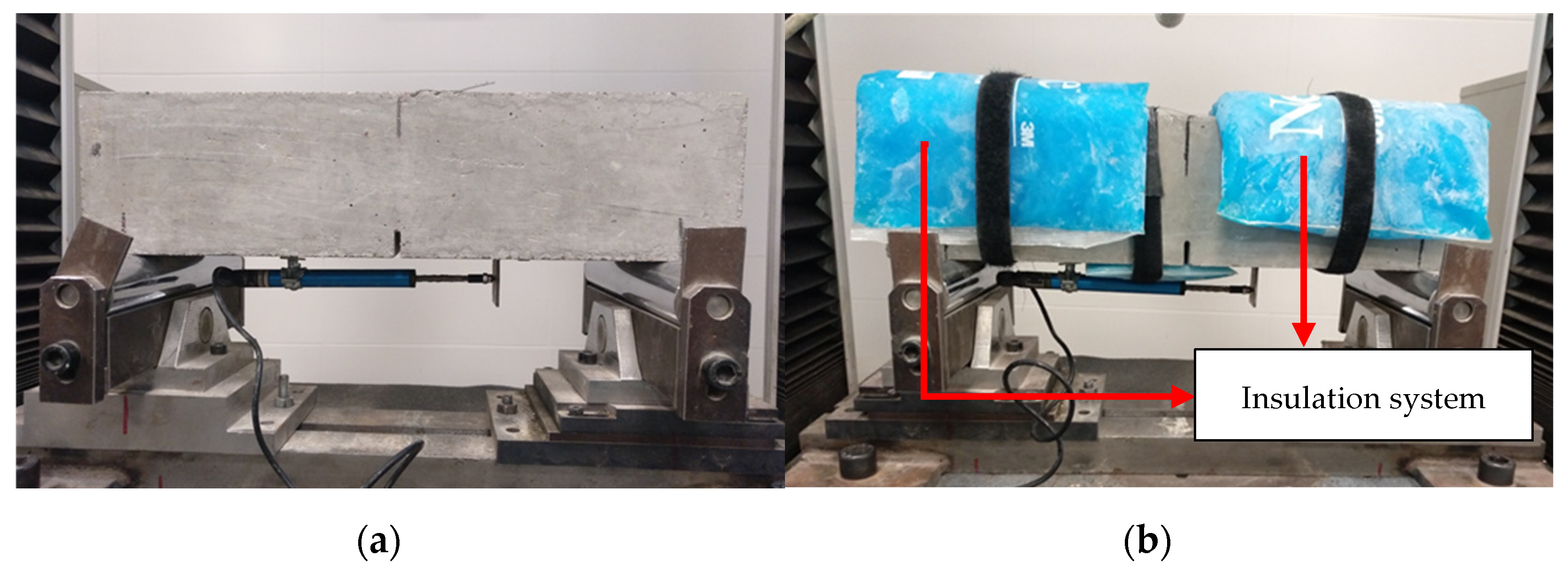

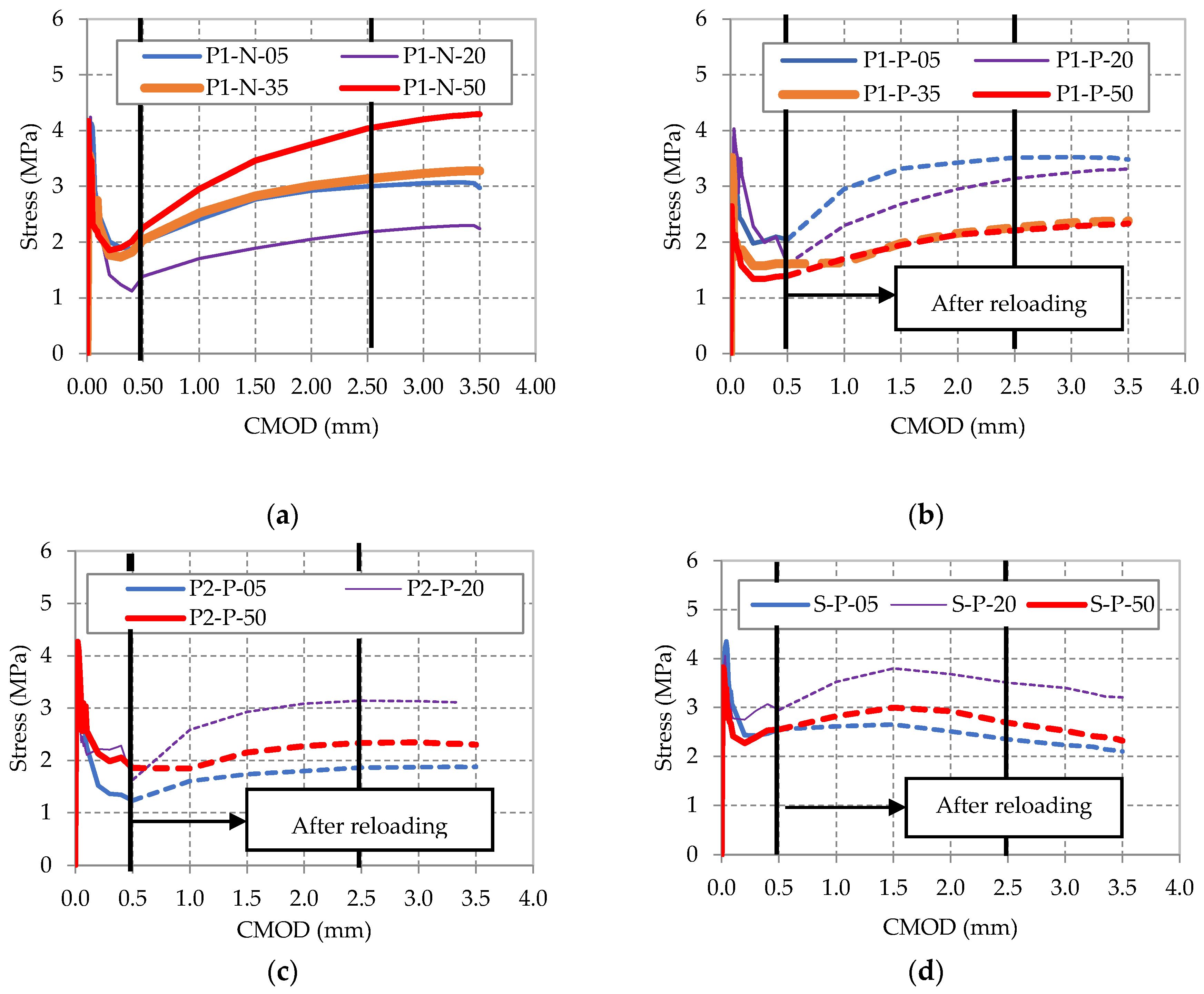

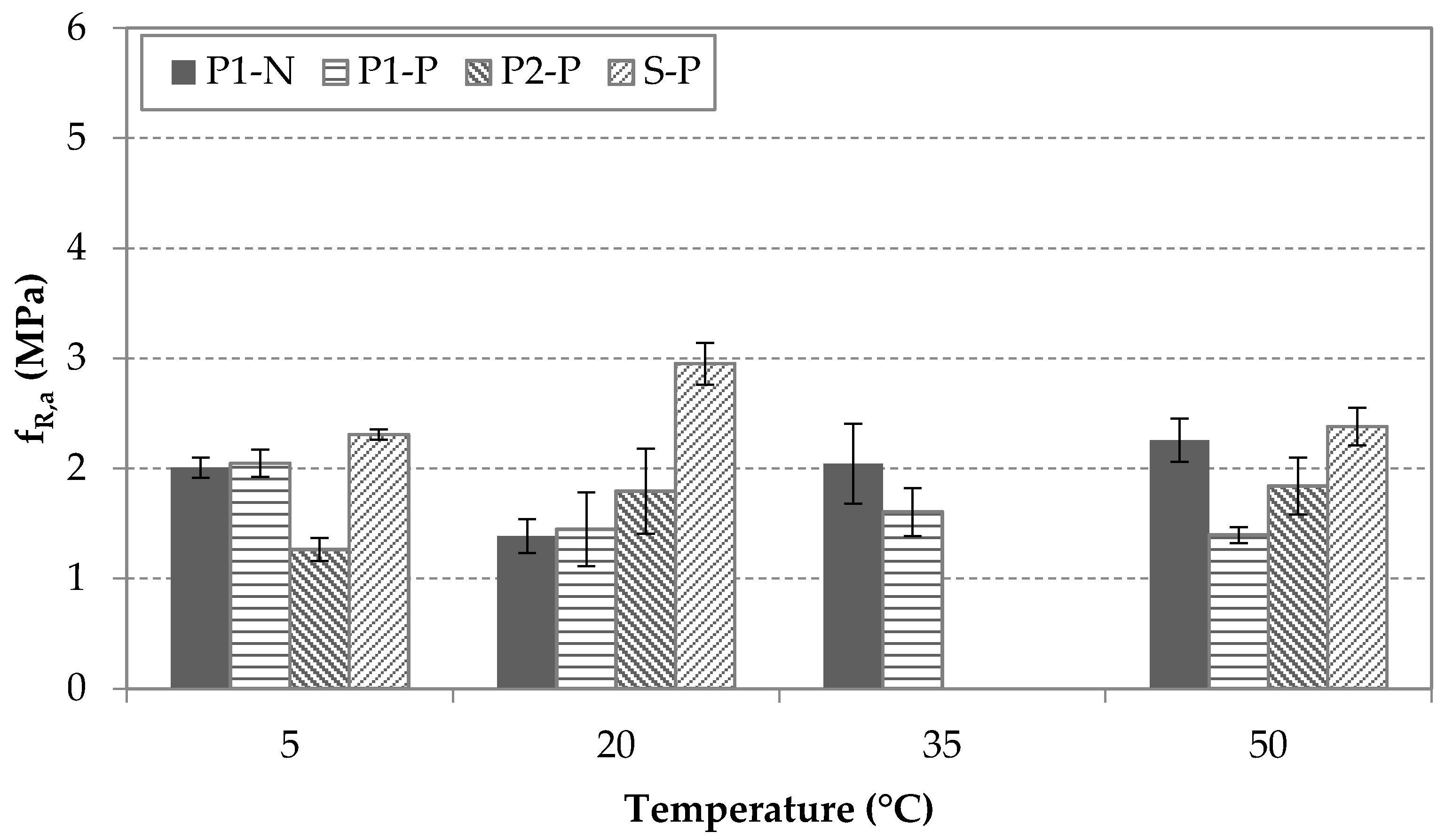
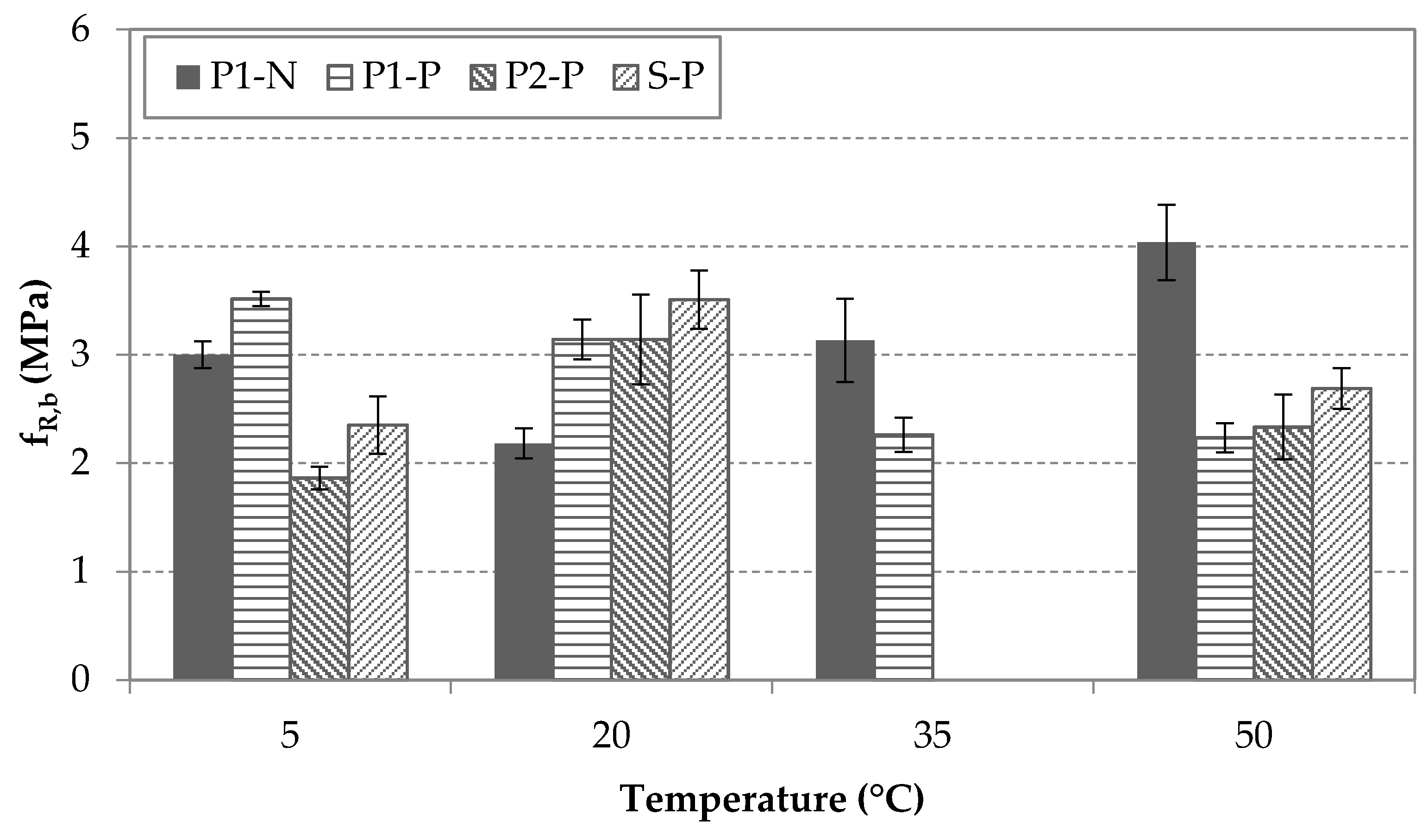

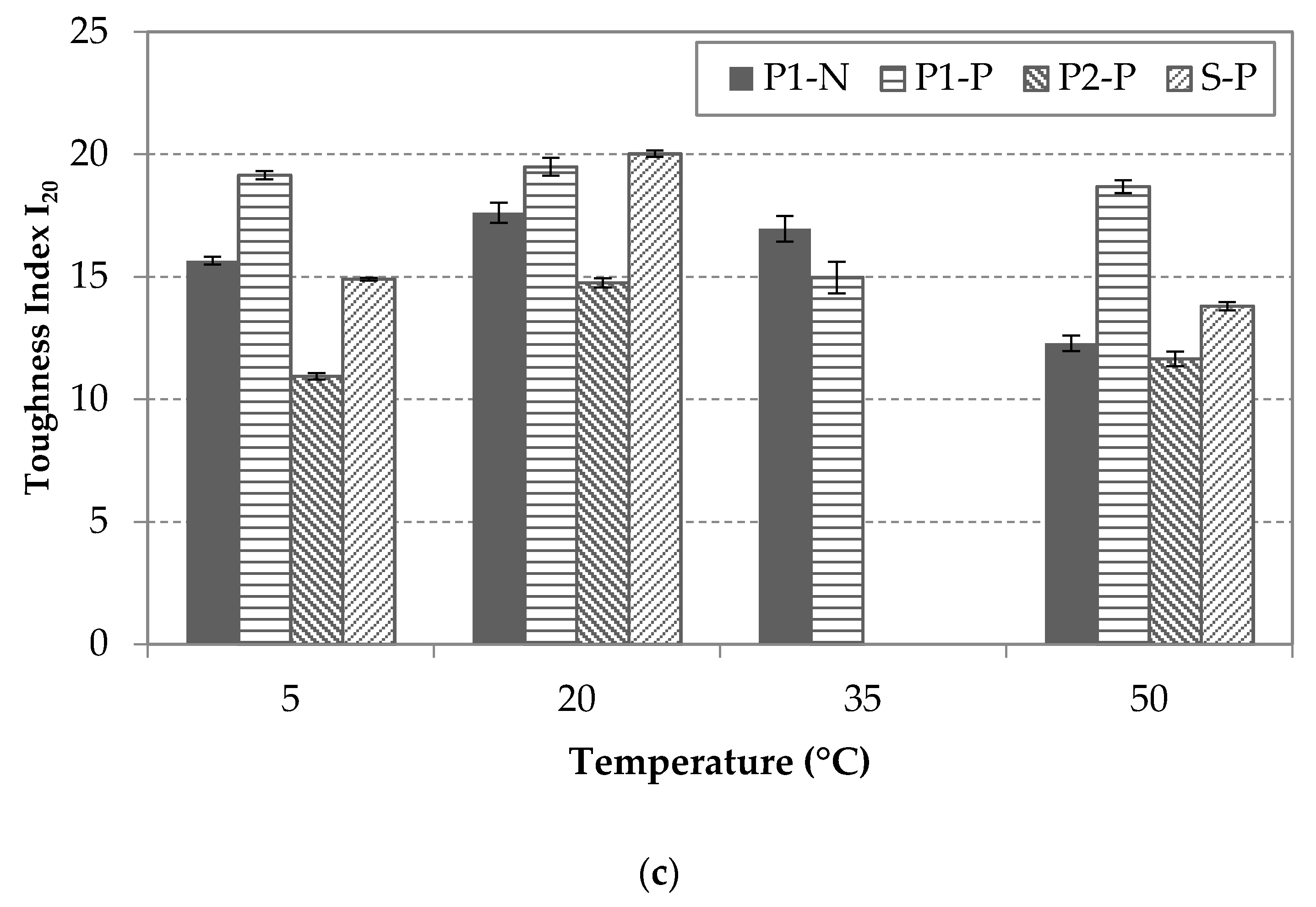
| Dosage FRCs (kg/m³) | |
|---|---|
| Cement II 42.5R | 325 |
| Crushed limestone gravel (6–10 mm) | 430 |
| Crushed limestone gravel (4–6 mm) | 580 |
| Natural sand (0–4 mm) | 835 |
| Limestone Filler | 80 |
| Water | 178.5 |
| Superplasticizer | 0.70% ± 0.2% |
| Code | Type | Length lf (mm) | Diameter df (mm) | Aspect Ratio | Melting Point (°C) | Tensile Strength (MPa) | Density (kg/m³) |
|---|---|---|---|---|---|---|---|
| P1 | Macrosynthetic | 35 | 1.00 | 35 | 170 | 550 | 920 |
| P2 | Macrosynthetic | 54 | 0.50 1 | 108 | 160 | 600 | 910 |
| S | Steel | 48 | 0.55 | 87 | 1375 | 1115 | 7850 |
| Code | Description | Characteristics of Conservation Condition | Image |
|---|---|---|---|
| 05 | Cool box Asfri Stock 100 (203 L) | 5 °C | 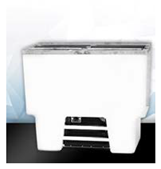 |
| 20 | Humidity Chamber | 20 °C, RH 95% | 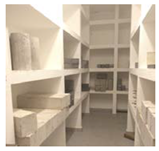 |
| 35 | Thermal bath (480 L) | 35 °C, specimens were submerged | 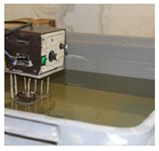 |
| 50 | Thermal bath (580 L) | 50 °C, specimens were submerged |
| Fiber Type | Pre-Cracking Age (Days) | Final Test Age (Days) | Batch | Temperature (°C) | Code | # of Specimens |
|---|---|---|---|---|---|---|
| P1 | Not pre-cracked | 60 | B1 | 05 | P1-N-05 | 4 |
| 20 | P1-N-20 | 4 | ||||
| B2 | 35 | P1-N-35 | 4 | |||
| 50 | P1-N-50 | 4 | ||||
| 28 | B3 | 05 | P1-P-05 | 4 | ||
| 20 | P1-P-20 | 4 | ||||
| B4 | 35 | P1-P-35 | 4 | |||
| 50 | P1-P-50 | 4 | ||||
| P2 | B5 | 05 | P2-P-05 | 4 | ||
| 20 | P2-P-20 | 4 | ||||
| B6 | 50 | P2-P-50 | 4 | |||
| S | B7 | 05 | S-P-05 | 4 | ||
| B8 | 20 | S-P-20 | 4 | |||
| 50 | S-P-50 | 4 |
| Batch | Code | Consistency Class | Compressive Strength | |
|---|---|---|---|---|
| fc,m (MPa) | CV (%) | |||
| B 1 | P1-N-05 P1-N-20 | S2 | 35.05 | 1.89 |
| B 2 | P1-N-35 P1-N-50 | S2 | 37.26 | 2.49 |
| B 3 | P1-P-05 P1-P-20 | S2 | 35.68 | 2.39 |
| B 4 | P1-P-35 P1-P-50 | S2 | 35.42 | 1.28 |
| B 5 | P2-P-05 P2-P-20 | S1 | 35.20 | 1.22 |
| B 6 | P2-P-50 | S1 | 36.47 | 2.53 |
| B 7 | S-P-05 | S3 | 31.60 | 5.80 |
| B 8 | S-P-20 S-P-50 | S3 | 32.73 | 1.46 |
| Code | P1-N | |||
|---|---|---|---|---|
| 5 °C | 20 °C | 35 °C | 50 °C | |
| (MPa) | 4.28 | 58 | 4.69 | 4.24 |
| CV (%) | 11.37 | 12.61 | 9.97 | 14.36 |
| (MPa) | 2.01 | 39 | 2.04 | 2.26 |
| CV (%) | 9.20 | 15.36 | 36.14 | 19.71 |
| (MPa) | 3.00 | 18 | 3.13 | 4.04 |
| CV (%) | 12.35 | 13.94 | 38.44 | 34.84 |
| Code | Age of Testing | P1-P | P2-P | S-P | |||||||
|---|---|---|---|---|---|---|---|---|---|---|---|
| 5 °C | 20 °C | 35 °C | 50 °C | 5 °C | 20 °C | 50 °C | 5 °C | 20 °C | 50 °C | ||
| (MPa) | 28 days | 3.67 | 4.15 | 3.98 | 4.24 | 3.91 | 4.36 | 5.10 | 4.43 | 4.27 | 4.36 |
| CV (%) | 4.23 | 9.40 | 29.76 | 2.78 | 8.65 | 6.85 | 6.59 | 6.73 | 3.43 | 2.64 | |
| (MPa) | 2.05 | 1.45 | 1.60 | 1.40 | 1.26 | 1.79 | 1.84 | 2.31 | 2.95 | 2.38 | |
| CV (%) | 3.32 | 33.66 | 21.69 | 7.22 | 10.34 | 38.69 | 25.93 | 4.74 | 18.96 | 17.20 | |
| (MPa) | 60 days | 3.52 | 3.14 | 2.26 | 2.23 | 1.86 | 3.14 | 2.33 | 2.35 | 3.51 | 2.69 |
| CV (%) | 6.53 | 18.36 | 15.76 | 13.57 | 10.64 | 41.36 | 29.93 | 26.43 | 26.94 | 18.84 | |
| Code | I5 | CV (%) | I10 | CV (%) | I20 | CV (%) |
|---|---|---|---|---|---|---|
| P1-N-05 | 4.38 | 11.57 | 7.80 | 13.46 | 15.70 | 15.37 |
| P1-N-20 | 3.69 | 41.83 | 6.41 | 40.87 | 12.50 | 41.04 |
| P1-N-35 | 4.47 | 25.50 | 7.99 | 37.80 | 16.96 | 52.44 |
| P1-N-50 | 3.11 | 22.09 | 5.62 | 27.08 | 12.28 | 32.25 |
| P1-P-05 | 4.10 | 12.01 | 9.71 | 15.50 | 19.15 | 16.52 |
| P1-P-20 | 5.14 | 18.41 | 9.35 | 32.00 | 19.49 | 36.60 |
| P1-P-35 | 4.67 | 9.25 | 9.87 | 5.37 | 14.94 | 64.62 |
| P1-P-50 | 4.17 | 4.92 | 10.71 | 28.79 | 18.68 | 26.12 |
| P2-P-05 | 3.73 | 10.93 | 5.99 | 11.50 | 10.94 | 12.69 |
| P2-P-20 | 3.95 | 26.14 | 9.75 | 43.61 | 14.75 | 18.89 |
| P2-P-50 | 3.90 | 12.74 | 7.41 | 22.78 | 11.65 | 29.30 |
| S-P-05 | 4.33 | 11.96 | 7.70 | 11.93 | 14.90 | 4.83 |
| S-P-20 | 4.79 | 5.65 | 9.68 | 8.64 | 20.02 | 12.91 |
| S-P-50 | 3.68 | 12.31 | 7.06 | 14.66 | 13.78 | 17.36 |
| Source | Square Sum (SS) | DF | Mean Square (MS) | F-Value | p-Value |
|---|---|---|---|---|---|
| Factor (Between) | 1.49085 | 3 | 0.49695 | 7.68 | 0.0059 |
| Error (Within) | 0.647242 | 10 | 0.0647242 | ||
| Total | 2.13809 | 13 |
| Source | Square Sum (SS) | DF | Mean Square (MS) | F-Value | p-Value |
|---|---|---|---|---|---|
| Factor (Between) | 3.15172 | 2 | 1.57586 | 15.15 | 0.0013 |
| Error (Within) | 0.93615 | 9 | 0.104017 | ||
| Total | 4.08787 | 11 |
| Source | Square Sum (SS) | DF | Mean Square (MS) | F-Value | p-Value |
|---|---|---|---|---|---|
| Factor (Between) | 0.0582 | 2 | 0.0291 | 0.72 | 0.5122 |
| Error (Within) | 0.363025 | 9 | 0.0403361 | ||
| Total | 0.421225 | 11 |
| Source | Square Sum (SS) | DF | Mean Square (MS) | F-Value | p-Value |
|---|---|---|---|---|---|
| Factor (Between) | 0.840602 | 3 | 0.280201 | 2.13 | 0.1603 |
| Error (Within) | 1.31748 | 10 | 0.131748 | ||
| Total | 2.15809 | 13 |
| Source | Square Sum (SS) | DF | Mean Square (MS) | F-Value | p-Value |
|---|---|---|---|---|---|
| Factor (Between) | 0.879017 | 2 | 0.439508 | 2.12 | 0.1756 |
| Error (Within) | 1.86235 | 9 | 0.206928 | ||
| Total | 2.74137 | 11 |
| Source | Square Sum (SS) | DF | Mean Square (MS) | F-Value | p-Value |
|---|---|---|---|---|---|
| Factor (Between) | 1.06622 | 2 | 0.533108 | 2.41 | 0.1452 |
| Error (Within) | 1.99115 | 9 | 0.221239 | ||
| Total | 3.05737 | 11 |
| Source | Square Sum (SS) | DF | Mean Square (MS) | F-Value | p-Value |
|---|---|---|---|---|---|
| Factor (Between) | 4.94657 | 3 | 1.64886 | 11.86 | 0.0009 |
| Error (Within) | 1.52917 | 11 | 0.139015 | ||
| Total | 6.47573 | 14 |
| Source | Square Sum (SS) | DF | Mean Square (MS) | F-Value | p-Value |
|---|---|---|---|---|---|
| Factor (Between) | 3.53105 | 2 | 1.766552 | 2.37 | 0.1485 |
| Error (Within) | 6.69125 | 9 | 0.743472 | ||
| Total | 10.2223 | 11 |
| Source | Square Sum (SS) | DF | Mean Square (MS) | F-Value | p-Value |
|---|---|---|---|---|---|
| Factor (Between) | 2.94935 | 2 | 1.47468 | 4.26 | 0.0499 |
| Error (Within) | 3.11565 | 9 | 0.346183 | ||
| Total | 6.065 | 11 |
Publisher’s Note: MDPI stays neutral with regard to jurisdictional claims in published maps and institutional affiliations. |
© 2021 by the authors. Licensee MDPI, Basel, Switzerland. This article is an open access article distributed under the terms and conditions of the Creative Commons Attribution (CC BY) license (https://creativecommons.org/licenses/by/4.0/).
Share and Cite
Caballero-Jorna, M.; Roig-Flores, M.; Serna, P. A Study of the Flexural Behavior of Fiber-Reinforced Concretes Exposed to Moderate Temperatures. Materials 2021, 14, 3522. https://doi.org/10.3390/ma14133522
Caballero-Jorna M, Roig-Flores M, Serna P. A Study of the Flexural Behavior of Fiber-Reinforced Concretes Exposed to Moderate Temperatures. Materials. 2021; 14(13):3522. https://doi.org/10.3390/ma14133522
Chicago/Turabian StyleCaballero-Jorna, Marta, Marta Roig-Flores, and Pedro Serna. 2021. "A Study of the Flexural Behavior of Fiber-Reinforced Concretes Exposed to Moderate Temperatures" Materials 14, no. 13: 3522. https://doi.org/10.3390/ma14133522






